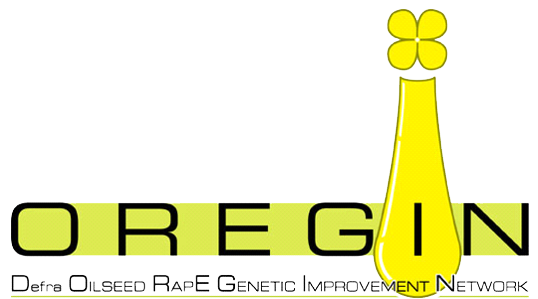Pathogen Collection
Rationale
To enable the reliable genetic analysis of complex disease resistance traits in B. napus, a core collection of isolates of the three major fungal pathogens causing economic losses in oilseed rape (OSR) crops, Pyrenopeziza brassicae, Leptosphaeria maculans and Leptosphaeria biglobosa was established. The genetic diversity within the pathogen collection was analysed to ensure that the assembled collection represented the majority of the pathogen diversity. This was necessary in order to enable future reliable genetic analysis of specific pathogen-host interactions in combination with the host crop DFFS. Framework standard operating procedures were established so that they can be applied to other oilseed rape pathogens in future projects associated with OREGIN.
Establishment of a worldwide OSR fungal pathogen resource collection
In 2003/04, isolates of Leptosphaeria maculans and isolates of Pyrenopeziza brassicae were assembled at Rothamsted Research from sources representative of the worldwide distribution of stem canker and light leaf spot epiphytotics in OSR. Information on these isolates and their properties was maintained in spreadsheets and a prototype database of the culture collection was tested and then made available on the OREGIN website. In 2004/05, additional collections were made from sources in western Australia, France, Portugal, Sweden, Germany and Scotland and the culture collection of pathogen isolates was enlarged with isolates of Leptosphaeria maculans and isolates of Pyrenopeziza brassicae. Information on the isolates and their properties was maintained in MS Excel spread sheets. Isolates were sourced and annotated. By April 2006, the culture collection comprised of Leptosphaeria maculans isolates andyrenopeziza brassicae isolates from the UK and other sources worldwide . These isolates are maintained at -80oC as conidial suspensions in 20 % glycerol and are kept in duplicate at Rothamsted Research and University of Warwick.
New pathogen isolates were icollected and added to the pathogen collection. These included 89 Leptosphaeria maculans isolates obtained from the 2014/15 cropping season to the 2020/2021 cropping season, 69 Leptosphaeria maculans isolates obtained from eight countries collected from the 2016/17 to 2020/2021 cropping seasons. Moreover pathogen isolates of Leptosphaeria biglobosa (co-existing pathogen causing phoma stem canker in the UK and other European countries and the pathogen responsible for the disease in China) were added to the OREGIN collection. Previously, there were no Leptosphaeria biglobosa isolates in the pathogen collection. There are 11 Leptosphaeria biglobosa isolates collected from the UK from the 2013/2014 to 2017/2018 cropping seasons, 12 isolates from Canada and 18 isolates from France collected from 2017/2018 to 2020/2021 cropping seasons. Pyrenopeziza brassicae isolates, there are 301 isolates collected from four different countries. New Pyrenopeziza brassicae isolates collected in the UK from 2018/2019 to 2020/2021 cropping season have been added the pathogen collection.
Secure storage of the “founder isolate” collection.
Stock cultures of all isolates are maintained in 20% glycerol at -80oC and as duplicate nutrient media slopes. DNA extracted from freeze-dried mycelia was isolated for analysis of genetic diversity using molecular markers. For L. maculans, six minisatellite markers were initially evaluated. Amplified fragment length polymorphism (AFLP) markers were adopted for the characterization of P. brassicae isolates.


